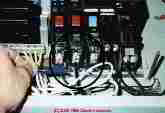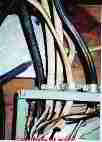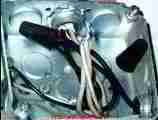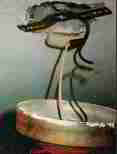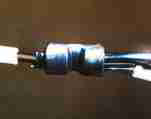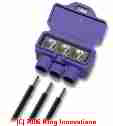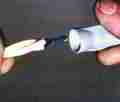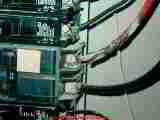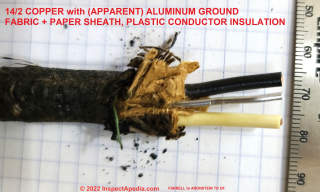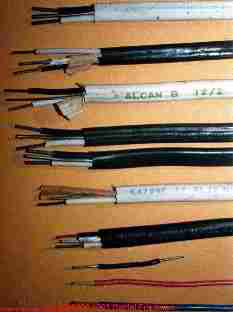 How to Recognize Aluminum Electrical Wiring in Buildings
How to Recognize Aluminum Electrical Wiring in Buildings
Tips for identifying aluminum wiring in homes
- POST a QUESTION or COMMENT about aluminum electrical wiring identification methods: what aluminum electrical wiring looks like, brands, labels, appearance
How to recognize or identify aluminum electrical wiring in buildings. This article provides tips and photographs helpful in identifying the presence of aluminum wiring in residential properties. Because we've had requests for help in identifying this wire we've included some tips.
Be sure to also look at other photographs available at the Aluminum Wiring Website as many of them show closeups of aluminum wire in various applications.
InspectAPedia tolerates no conflicts of interest. We have no relationship with advertisers, products, or services discussed at this website.
- Daniel Friedman, Publisher/Editor/Author - See WHO ARE WE?
How to Find or Identify Aluminum Electrical Wiring in Homes
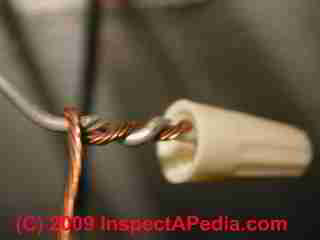 Here we describe how determine if your home has unsafe aluminum wiring: a fire hazard, and what to do about it if it's present. Simple visual inspection can find aluminum wiring and with a bit more visual inspection one can determine if it has been properly repaired to make it safe.
Here we describe how determine if your home has unsafe aluminum wiring: a fire hazard, and what to do about it if it's present. Simple visual inspection can find aluminum wiring and with a bit more visual inspection one can determine if it has been properly repaired to make it safe.
Watch out: unless you are specifically trained to do so, do not open or disassemble or touch any electrical panels, devices, components if you are not trained and competent. There is risk of fatal electric shock.
[Click to enlarte any image]
First let's discuss how you'll find out if your home contains aluminum wiring at all.
- When was the house built or re-wired or when were circuits added?
Homes built, rooms added, circuits rewired or added between 1965 and 1973 may contain aluminum wiring.
- Don't assume that there's no aluminum wire if your house was not built during these years.
Circuits may have been added, extended, modified using aluminum wiring.
Or an installer may have had leftover aluminum wire and used it in wiring a home or adding circuits even after 1973.
- An electrician or home inspector qualified to open the electric panel
will look at wire at circuit breakers in the
panel for aluminum wire.
The pen in the circled area points to bare silver-colored wire visible at the circuit breaker. Notice that the aluminum wire in this photo is a single circuit installed between two copper wires (on adjacent breakers).
Also notice the bare wire exposed at the neutral bus. An easy place to look for aluminum wire than at the circuit breakers might be at the neutral bus where both white neutral wires and ground wires are connected in a row
. There it's easier to see exposed portions of the wire itself.
- Look for the word "Aluminum" on the wire's insulating jacket.
Without opening any electrical panels or other devices, a homeowner or building inspector can still look at for printed or embossed letters on the plastic wire jacket where wiring is visible in the attic or at the electric panel.
Some aluminum wire has the word "Aluminum" or a specific brand name such as "Kaiser Aluminum" plainly marked on the plastic wire jacket.
This photo shows a dark colored wire jacket with green print indicating "Kaiser Aluminum."
Some white colored plastic wire jackets are inked in red; others have embossed letters without ink and are hard to read. Try shining a light along the wire
- Don't assume there's no aluminum wire just because you find none in
the panel.
Aluminum may have been used for part of circuits or for some but not other circuits in the building. - At outlets and switches, look at stripped wire ends. Often simply
removing the cover plate will give sufficient view.
Be especially cautious if you see back-wired receptacles. It may be difficult to see if the wire is aluminum, but if it is, the smaller wire contact surface when this method was used may increase the risk of overheating or other failures.
- In the attic look at the wire gauge or "size."
Look for #12-gauge wires in the attic or other places where wiring is readily available.
If you see only #12 and no #14, aluminum wiring may be present.
Aluminum wire must be one wire gauge size larger for a given circuit than if copper was used.
So while #14 copper wire is permitted on a 15-amp electrical circuit and since #14 copper wire branch circuits are common in homes, if aluminum wire was used for the same circuit it would have to be #12. Similarly, a 20-amp circuit uses #12 copper wire or #10 aluminum wire.
Common residential lighting and electrical-receptacle circuits are 15-amp or possibly 20-amp (e.g. in a kitchen).
So if you see only #12 or larger wires in the attic of your house look further to see if it's aluminum. The wire-gauge size is printed or embossed on the wire jacket. #12 does not guarantee it's aluminum, it's just more data to point in that direction.
- Where wiring is visible in the attic or basement, examine the insulation for markings that indicate
the use of aluminum, such as "KAISER," "ALCAN," "ALUMINUM," or "AL/2." If you see #14, or 14-gauge wiring, that particular wire
is unlikely to be aluminum, unless someone did something
quite unusual for residential construction.
Here's a closeup of some aluminum wiring insulation jacketing which shows the "12/2" indicating it's No. 12 gauge wire. [Photo]
- Aluminum wires spliced together in this metal junction box has not overheated. It was exposed by an electrician.
A homeowner should not be taking the risk of opening and exposing electrical wiring.
- Aluminum wiring spliced to stranded copper wire in a ceiling light fixture was found during a wiring survey I performed - a common condition.
- COPALUM Copper-to-Aluminum Pigtailing repairs may be observed in homes where this special AMP (now TYCO) COPALUM connector and special tool
were used to
connect short copper wires to aluminum wire ends in the building.
The TYCO COPALUM connector method is described
at PIGTAILING USING AMP "COPALUM" CONNECTORS Typically this approach costs about half that of completely re-wiring a home with copper.
COPALUM ALUMINUM WIRING CONNECTOR AVAILABILITY discusses how to get the proper aluminum wire connectors
- AlumiConn connectors and aluminum wire aluminum to copper lug connectors used for pigtailing or splicing
may be observed in homes where aluminum wiring repairs have begun
after about June 2007.
[New in 2006, U. L. Listed, 2007 completed independent testing], recommended by CPSC 2011.
- Scotchlok 3M Repair Method [- Superceded by new alternate repair as of June 2007 -] was previously recommended, prior to successful testing of the AlumiConn
see AlumiConn and COPALUM methods introduced
at ALUMINUM WIRING REPAIR METHODS.
We no longer recommend this repair method, but in because it may be encountered in the field, a summary description of this method is
at PIGTAILING USING "Scotchlok" TWIST-ON CONNECTORS and a detailed description of this method is
at ALUMINUM WIRE ALTERNATIVE REPAIR Special Aluminum Wire Repair Method using a Specific Twist-on Connector (Scotchlok 3M) and Other Details
- The Ideal 65 Purple Twister, A Not-Recommended "Repair" attempt for aluminum wiring using a twist-on connector was evident in this electrical panel.
When I found this condition I suspected, and then confirmed that the worker who tried this approach did not follow CPSC recommendations, used an inappropriate connector which has a record of fires, and further, had failed to find and repair any of the splices in junction boxes in the building.
Work like this is done by someone who has heard vaguely about "copper pigtailing" but has not become well informed on the topic. In my opinion, an improper or partial "repair" can in such cases actually increase the risk of overheating and fire.
- Overheated, burned multi-strand aluminum wire in this electric panel confirms that even contemporary practice of using multi-strand aluminum wiring in buildings, typically for single-use circuits like air conditioning, electric ranges, or clothes dryers, is still vulnerable to burnouts.
- Copper conductors with aluminum ground, see details
at UNIDENTIFIED Fabric Insulated COPPER Conductors with ALUMINUM GROUND
Watch out: these conditions indicate fire hazards in your building.
Other "Silver-Colored" Wires that May Not be Aluminum
Watch out: don't be fooled by thinking that every silver-colored electrical wire is aluminum. There are at least two other silver-colored wires that you may encounter in buildings that are not aluminum:
- Tinned copper or plated copper wire: this is copper wire coated with a tin plating. It's easily identified by scraping the wire surface enough to remove the plating and expose the red-copper wire beneath.
Watch out: of course never try such as foolish trick without first dropping electrical power to the wire in question and confirming that power is in fact "off"
See details at TINNED COPPER WIRE IDENTIFICATION - Steel electrical wire or plated steel wire: in the U.S. and possibly some other countries, homes built during World War II may have been wired with all steel electrical wire or with plated steel wire.
[Thanks to Dr. Jess Aronstein for this tip. Jess reported: Possibly even plated steel. A friend once lived in a house built during WWII that had (all) steel wiring. - personal communication 2021/02/26 - Ed.]
Bottom line: you cannot assume that all copper-colored wire is solid copper (it may be copper plated aluminum, for example), nor that all silver colored wire is aluminum. Every imaginable combination of core and top surface coatings have been tried for electrical wires across a wide range of applications: tin plated copper, nickel plated copper, copper plated steel, copper plated aluminum, tin platings, etc, from A to Z: literally - electrical wire plating, whether used on copper or on steel, may have been a zinc coating, (Jakubeniene 2006)
7 Points of Key Aluminum Wiring Repair Advice
Home inspectiors and electricians should give appropriate warnings to homeowners or customers including the following:
- Watch out: Aluminum Electrical Wiring is a Fire Hazard in Homes unless it has been properly repaired (or removed entirely)
see ALUMINUM WIRING SAFETY ASSESSMENT - CPSC.
For help in recognizing aluminum electrical wiring in homes
see ALUMINUM WIRING IDENTIFICATION. - Aluminum wire repair cost:
Aluminum Electrical Wiring repairs in a home where that work has not been performed will be a significant expense - Aluminum wire repair urgency:
Aluminum wiring repairs should not be deferred, as the risk increases with age and use of the electrical system; meanwhile be sure that the home has working smoke detectors, and turn off any circuits behaving oddly. - Who can repair aluminum electrical wire?
Aluminum wiring repairs should be performed only by a licensed electrician who is well informed about the correct repair methods. Using an improper repair method may actually increase the risk of a fire.
See ALUMINUM WIRING REPAIR ELECTRICIANS - Which aluminum wire repair methods are acceptable?
Use one of the repair methods recommended by the US CPSC:
Replace the aluminum wire with copper.
Use the AMP / TYCO COPALUM connector to pigtail copper extensions to every aluminum branch circuit wire end
See PIGTAILING USING AMP "COPALUM" CONNECTORS.
Use the AlumiConn™ connector to pigtail copper extensions to every aluminum branch circuit wire end
ALUMINUM WIRE AlumiConn describes using this device and how it is connected, wired, and torqued.
Details of procedures to make aluminum wiring safe are
at ALUMINUM WIRING REPAIR METHODS - home
- Are some aluminum wire repair methods unsafe?
Yes. Do not use any of the following aluminum wiring repair methods- COALR or CU-AL devices -
see ALUMINUM WIRING REPAIR COALR & CU-AL - Twist-on connectors such as the Ideal-65 purple "twister" or other connection methods not recommended by the CPSC
see ALUMINUM WIRING REPAIRS NOT-RECOMMENDED
- COALR or CU-AL devices -
- Feel free to copy and place the following ALUMINUM WIRIING SUMMARY free to copy page at your website or to make printed copies to give to consumers at no charge
Aluminum Wire Repair & Safety Documents & Supporting Research
- ALUMINUM WIRE REPAIR METHODS to reduce risk in buildings with Aluminum Electrical Wiring - Overview of Acceptable Repair Practices (in the document you are presently viewing)
- FIRE HAZARDS WITH ALUMINUM-TO-COPPER TWIST-ON-CONNECTORS & Acceptable Aluminum Wiring Repair Practices Color Photos, Current Issues. 9/28/95 CPSC Meeting Minutes - warning about which pigtailing-to-copper connectors to use and which to avoid.
- REDUCING THE FIRE HAZARDS in ALUMINUM-WIRED HOMES, Jess Aronstein, Ph.D., This document answers most technical questions about the hazards and remedies of aluminum electrical wiring.
- REPAIRING ALUMINUM WIRING, US CPSC Pub. No. 516 U.S. Consumer Product Safety Commission Publication available online here as a free PDF download
- Chivavibul, Pornthep, Manabu Enoki, Shigeru Konda, Yasushi Inada, Tamotsu Tomizawa, and Akira Toda. "Application of electroless-plated magnetic coating to reduce core loss of electrical steel." In Advanced Materials Research, vol. 117, pp. 21-25. Trans Tech Publications Ltd, 2010.
- Jakubeniene, Marija, Algirdas Zakaras, Zita Nijole Minkuviene, and Alvydas Benoshys. "Application of atomic absorption spectroscopy for detection of multimetal traces in low-voltage electrical marks." Forensic science international 161, no. 1 (2006): 36-40.
- Stout, David A. "Applications of surface analysis in the wire industry." Applications of Surface Science 15, no. 1-4 (1983): 166-177.
Abstract
The quality of wire is judged not only by its physical properties such as tensile strength and fatigue resistance, but also by its surface finish. The surface roughness, oxide formation, cleanliness, and plating homogeneity and porosity are just a few of the surface properties than can influence the performance of a wire product. Coupled to this is the large amount of surface area generated in drawing wire. For example, a ten pound spool holds nine miles of 0.006″ diameter stainless steel wire.
For these reasons surface analysis has become important both to the manufacturer and consumer of wire products. When surface analysis equipment such as AES, ESCA, and SIMS was first becoming commercially available in the late sixties and early seventies, the wire industry was beginning to enter a phase of technological development for many of its products.
Wire manufacturers and users began using surface analysis to investigate such topics as adhesion of brass plated automobile tire cord to rubber and diffusion of layered deposits. Examples of surface analysis used for process control, problem solving, and project development include discoloration problems on stainless steel wire, welding problems with composite wires, diffusion formed brass coatings, and diffusion problems with solder coated and Cu plated steel wire.
Excerpt:
... and diffusion problems with solder coated and Cu plated steel wire ...
...
Reader Comments, Questions & Answers About The Article Above
Below you will find questions and answers previously posted on this page at its page bottom reader comment box.
Reader Q&A - also see RECOMMENDED ARTICLES & FAQs
On 2021-03-11 by (mod) - Clifton-conduit-E-7032-Type-NM-12/2 electrical wire: aluminum wiring hazard warnings
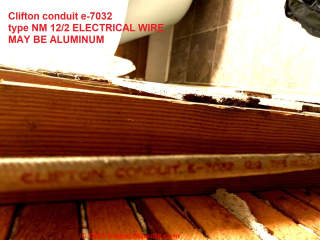 @Anonymous,
@Anonymous,
Watch out: Aluminum wire may have been added for more than 1 circuit, and may not be so labeled.
An electrician, inspecting in the electrical panel and in electrical boxes where your Clifton Conduit #12 wire is present can easily see the stripped metal wire ends to determine if aluminum wire is present - as I suspect it is.
Often the use of #12 wire on what's usually a 15 amp circuit is a Clue.
On 2021-03-11 by Anonymous
thank you, the home was built in 1925 and in the Portland Oregon area. There are a lot of different types of wiring. Before I moved in the seller did some repairs to the wiring and I had it reinspected. It was deemed safe, based on what they could see.
My house was previous a rental for many years and it is becoming apparent it was subject to many haphazard and cheap repairs.
The wire does not have AL or CU or anything else I can find indicating material on it. The switch does not appear to be connected to anything else so I don’t know if it was for a light, fan or heater that has since been removed. The box for the switch is also packed with what looks like fiberglass insulation, which I have never seen before.
This Q&A were posted originally
at FABRIC NMC WIRE INSULATION IDENTIFICATION
Question: when did they stop using aluminum electrical wiring? 1971, 1973, 1976 ?
2019/10/13 Doug Rudder
I am thinking about buying a 1972 singlewide trailer for a rental in florida ive researched and get 3 different years 1971, 1973, 1976.
I wish that I could get a concrete answer for sure when aluminum wiring was stopped being used and copper began.
Reply: By 1973 MOST BUT NOT ALL electricians stopped installing aluminum wiring in U.S. homes
Doug
You're right to gripe about getting a clear answer to "when did they stop using aluminum electrical wiring".
Putting a date on the aluminum electrical wiring can be tricky, because there were different hazards reported both with "old technology" aluminum wire that was installed up to 1972, and "new technology" aluminum wire that was installed later but at least some of which was equally hazardous.
Homes built before 1965 are unlikely to have aluminum branch circuit wiring. Homes in the United States built, rooms added, and circuits rewired or added between 1965 and 1973 may contain aluminum wiring. Canadian homes built during a similar problem also often included aluminum wiring, though some Canadian officials take a less cautious view of the aluminum wiring fire hazard than those in the U.S.
Watch out: In my OPINON it is dead wrong and a dangerous mistake to even try to rule in or rule out the presence of an aluminum wiring hazard at a home simply by looking at the home's manufacturing or construction date alone.
Instead one should actually inspect the wiring in the home for the presence of aluminum electrical wire. That step can rule in or out the aluminum wiring hazard based on fact, not speculation.
Why take the factual, inspection approach?
Because aluminum wire branch circuit conductors were sometimes installed in homes built both before aluminum wire was in common use as well as after. For example a home wired entirely with copper and built in 1955 might have had circuits installed using aluminum wire in 1972.
Similarly a home built in 1973 may have had an aluminum wire circuit added by an electrician using "new old stock" aluminum wire.
Bottom line: if you find solid conductor aluminum electrical wiring in your home you should consider it unsafe. Don't rely on a guess or the age of the home. Instead, look at the electrical wiring.
So take a look at ALUMINUM WIRING IDENTIFICATION
and have your electrician or home inspector actually look at the wiring - it's easy to identify aluminum conductors.
Finally: IF a home has had aluminum wiring installed, that wiring is unsafe and is a fire hazard UNLESS the wiring has either been replaced entirely with copper OR has been repaired using the two US CPSC approved connectors for pigtailing to copper: the AMP COPALUM or the AlumiConn. Both of those are discussed at this website.
On 2017-10-02 by DFK
Thank you. I am house hunting and this article is very helpful.
On 2016-12-19 by Dan Quintos
I was inspecting a center row-house built approx. 1980. When I looked at the electrical panel, one of the wires caught my eye as it had the following label - LOOMEX-7-NMD-12/2. Could this possibly be aluminum wiring? I'm in Toronto, Canada.
Thanks!
On 2016-10-18 by Paul Henderson
My house has the proper aluminum Plugs and switches throughout. Why isn't this approved by citizens as long as a licensed electrician installs and certifies the installation. The house has been here for 45 years and no handy men have touched the system. I have noticed only three places where the wires appeared to have over heated.
On 2016-08-16 by (mod) -
You might make connections that are improper, overheat, catch fire.
Or by tightening connections you might slightly reduce risk - at the point of those connections - for a time.
Or by wiggling wires around you might loosen a connection increasing the chance of a subsequent failure, overheat, fire.
On 2016-08-15 by Cathy
What will ocurr if you change outlets and do not know If you have aluminum wiring.
On 2015-11-21 by (mod) - no #14 Aluminum Wire in residential home circuits
Considering the age of your home there could be aluminum wiring. Your electrician can open the electrical panel: that's a good place to start looking for aluminum wire.
Yes a #14 copper wire may have been spliced onto a #12 aluminum wire as part of repairing aluminum wiring.
Watch out: such pigtailining splices must have been made using one of the two US CPSC recommended connectors: the AMP COPALUM crimp connector or the AlumiConn connector produced later.
In residential use the smallest aluminum wire gauge you'd expect to find installed in a home's branch circuit wiring is #12 aluminum on a 15-Amp electrical circuit.
A copper wire on a 15-Amp circuit would commonly be size No. 14 but not aluminum. Aluminum wire used in electrical circuits will be one size larger than its copper wire sister.
On 2015-11-21 by Anonymous - Anaconda Aluminum Wire?
Hello, thanks for the info. My mobile home is a 1972 Brookwood. One of the bedrooms has wires exposed from the ceiling. the seller took her chandelier out & the wires say Anaconda #14 on them.
A couple of the wires are white copper wires & there are 3 black wires also. Is it possible those wires were pig tailed onto the aluminum wires?
The seller said she lived there for 6 years & never had any electrical problems & mentioned that she had an electrician friend check it out after she moved in because she has a small child! She also mentioned that the previous owner who she purchase it from, had the circuit breaker moved into the home form outside.
I just purchased the home recently!
Wes
Question: is LED wiring the same as aluminum wire?
(Apr 11, 2014) lucie said:
is led wiring the same as aluminium wire
If you meant "lead" - lead was not used as the electrical conductor in building wiring.
And of course lead (Pb in the atomic chart) is a different metal from alumionum (Al ).
Reply: No.
Lucie,
I don't know what you are referring to. In general the triplet LED refers to "light emitting diodes"
which has nothing to do with aluminum electrical wiring.
(Apr 27, 2014) RuD said:
I guess she meant lead
Reply:
RuD
I'm not sure we've encountered lead electrical wiring either.
...
Continue reading at COPPER-CLAD ALUMINUM WIRE (safe in homes) where we distinguish among copper-clad aluminum wire, plated copper wire, and CU/AL or COLAR devices, or select a topic from the closely-related articles below, or see the complete ARTICLE INDEX.
Or see these
Recommended Articles
- ALUMINUM-WIRED HOMES, REDUCE THE HAZARD - PDF
- ALUMINUM WIRING GUIDE for HOME INSPECTORS
- ALUMINUM WIRING IDENTIFICATION
- ALUMINUM WIRING REPAIR METHODS
- ALUMINUM WIRING REPAIR ELECTRICIANS
- ALUMINUM WIRING REPAIR METHODS - CPSC Meeting 9/28/95
- ALUMINUM WIRING REPAIRS NOT-RECOMMENDED
- REDUCE THE AL WIRE RISK: DETAILS
Suggested citation for this web page
ALUMINUM WIRING IDENTIFICATION at InspectApedia.com - online encyclopedia of building & environmental inspection, testing, diagnosis, repair, & problem prevention advice.
Or see this
INDEX to RELATED ARTICLES: ARTICLE INDEX to ELECTRICAL INSPECTION & TESTING
Or use the SEARCH BOX found below to Ask a Question or Search InspectApedia
Ask a Question or Search InspectApedia
Try the search box just below, or if you prefer, post a question or comment in the Comments box below and we will respond promptly.
Search the InspectApedia website
Note: appearance of your Comment below may be delayed: if your comment contains an image, photograph, web link, or text that looks to the software as if it might be a web link, your posting will appear after it has been approved by a moderator. Apologies for the delay.
Only one image can be added per comment but you can post as many comments, and therefore images, as you like.
You will not receive a notification when a response to your question has been posted.
Please bookmark this page to make it easy for you to check back for our response.
IF above you see "Comment Form is loading comments..." then COMMENT BOX - countable.ca / bawkbox.com IS NOT WORKING.
In any case you are welcome to send an email directly to us at InspectApedia.com at editor@inspectApedia.com
We'll reply to you directly. Please help us help you by noting, in your email, the URL of the InspectApedia page where you wanted to comment.
Citations & References
In addition to any citations in the article above, a full list is available on request.
- Our recommended books about building & mechanical systems design, inspection, problem diagnosis, and repair, and about indoor environment and IAQ testing, diagnosis, and cleanup are at the InspectAPedia Bookstore. Also see our Book Reviews - InspectAPedia.
- In addition to citations & references found in this article, see the research citations given at the end of the related articles found at our suggested
CONTINUE READING or RECOMMENDED ARTICLES.
- Carson, Dunlop & Associates Ltd., 120 Carlton Street Suite 407, Toronto ON M5A 4K2. Tel: (416) 964-9415 1-800-268-7070 Email: info@carsondunlop.com. Alan Carson is a past president of ASHI, the American Society of Home Inspectors.
Thanks to Alan Carson and Bob Dunlop, for permission for InspectAPedia to use text excerpts from The HOME REFERENCE BOOK - the Encyclopedia of Homes and to use illustrations from The ILLUSTRATED HOME .
Carson Dunlop Associates provides extensive home inspection education and report writing material. In gratitude we provide links to tsome Carson Dunlop Associates products and services.


